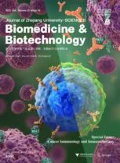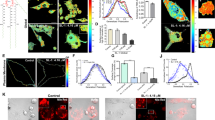Abstract
Mycoplamas are a group of wall-less prokaryotes widely distributed in nature, some of which are pathogenic for humans and animals. There are many lipoproteins anchored on the outer face of the plasma membrane, called lipid-associated membrane proteins (LAMPs). LAMPs are highly antigenic and could undergo phase and size variation, and are recognized by the innate immune system through Toll-like receptors (TLR) 2 and 6. LAMPs can modulate the immune system, and could induce immune cells apoptosis or death. In addition, they may associate with malignant transformation of host cells and are also considered to be cofactors in the progression of AIDS.
Similar content being viewed by others
References
Akira, S., Takeda, K., Kaisho, T., 2001. Toll-like receptors: critical proteins linking innate and acquired immunity. Nat. Immunol., 2(8):675–680. [doi:10.1038/90609]
Baseman, J.B., Lange, M., Criseimagna, N.L., Giron, J.A., Thomas, C.A., 1995. Interplay between mycoplasmas and host target cells. Microb. Pathog., 19(2):105–116. [doi:10.1006/mpat.1995.0050]
Buwitt-Beckmann, U., Heine, H., Wiesmuller, K.H., Jung, G., Brock, R., Akira, S., Ulmer, A.J., 2005. Toll-like receptor 6-independent signaling by diacylated lipopeptides. Eur. J. Immunol., 35(1):282–289. [doi:10.1002/eji.200424955]
Chambaud, I., Wroblewski, H., Blanchard, A., 1999. Interactions between mycoplasma lipoproteins and the host immune system. Trends Microbiol., 7(12):493–499. [doi:10.1016/S0966-842X(99)01641-8]
Davis, K.L., Wise, K.S., 2002. Site-specific proteolysis of the MALP-404 lipoprotein determines the release of a soluble selective lipoprotein-associated motif-containing fragment and alteration of the surface phenotype of Mycoplasma fermentans. Infect. Immun., 70(3):1129–1135. [doi:10.1128/IAI.70.3.1129-1135.2002]
Feng, S.H., Tsai, S., Rodriguez, J., Lo, S.C., 1999. Mycoplasmal infections prevent apoptosis and induce malignant transformation of interleukin-2-dependent 32D hematopoietic cells. Mol. Cell Biol., 19(12):7995–8002.
Fujita, M., Into, T., Yasuda, M., Okusawa, T., Hamahira, S., Kuroki, Y., Eto, A., Nisizawa, T., Morita, M., Shibata, K.I., 2003. Involvement of leucine resides at position 107, 112, and 115 in a leucine-rich repeat motif of human Toll-like receptor 2 in the recognition of diacylated lipoprotein and lipopeptide and Staphylococcus aureus peptidoglycans. J. Immunol., 171(7):3675–3683.
Garcia, J., Lemercier, B., Roman-Roman, S., Rawadi, G., 1998. A Mycoplasma fermentans-derived synthetic lipopeptide induces AP-1 and NF-κB activity and cytokine secretion in macrophages via the activation of mitogen-activated protein kinase pathways. J. Biol. Chem., 273(51):34391–34398. [doi:10.1074/jbc.273.51.34391]
Hall, R.E., Agarwal, S., Kestler, D.P., 2000. Induction of leukemia cell differentiation and apoptosis by recombinant P48, a modulin derived from Mycoplasma fermentans. Biochem. Biophys. Res. Commun., 269(1):284–289. [doi:10.1006/bbrc.2000.2282]
Henderson, B., Poole, S., Wleson, M., 1996. Bacterial modulins: a novel class of virulence factors which cause host tissue pathology by inducing cytokine synthesis. Microbiol. Rev., 60(2):316–341.
Horino, A., Sasaki, Y., Sasaki, T., Kenri, T., 2003. Multiple promoter inversions generate surface antigenic variation in Mycoplasma penetrans. J. Bacteriol., 185(1):231–242. [doi:10.1128/JB.185.1.231-242.2003]
Into, T., Nodasaka, Y., Hasebe, A., Okuzawa, T., Nakamura, J., Ohata, N., Shibata, K., 2002a. Mycoplasmal lipoproteins induce Toll-like receptor 2 and caspases-mediated cell death in lymphocytes and monocytes. Microbiol. Immunol., 46(4):265–276.
Into, T., Okada, K., Inoue, N., Yasuda, M., Shibata, K., 2002b. Extracellular ATP regulates cell death of lymphocytes and monocytes induced by membrane-bound lipoproteins of Mycoplasma fermentans and Mycoplasma salivarium. Microbiol. Immunol., 46(10):667–675.
Into, T., Kiura, K., Yasuda, M., Kataoka, H., Inoue, N., Hasebe, A., Takeda, K., Akira, S., Shibata, K., 2004. Stimulation of human Toll-like receptor (TLR) 2 and TLR6 with membrane lipoproteins of Mycoplasma fermentans induces apoptotic cell death after NF-kappa B activation. Cell. Microbiol., 6(2):187–199. [doi:10.1046/j.1462-5822.2003.00356.x]
Iyama, K., Zhang, S., Lo, S.C., 2001. Effects of mycoplasmal LAMPs on receptor responses to steroid hormones in mammalian cells. Curr. Microbiol., 43(3):163–169. [doi:10.1007/s002840010281]
Mühlradt, P.F., Schade, U., 1991. MDHM, a macrophage-stimulatory product of Mycoplasma fermentans, leads to in vitro interleukin-1 (IL-1), IL-6, tumor necrosis factor, and prostaglandin production and is pyrogenic in rabbits. Infect. Immun., 59(11):3969–3974.
Mühlradt, P.F., Frisch, M., 1994. Purification and partial biochemical characterization of a Mycoplasma fermentans-derived substance that activates macrophages to release nitric oxide, tumor necrosis factor, and interleukin-6. Infect. Immun., 62(9):3801–3807.
Mühlradt, P.F., Kiess, M., Meyer, H., Sussmuth, R., Jung, G., 1997. Isolation, structure elucidation, and synthesis of a macrophage stimulatory lipopeptide from Mycoplasma fermentans acting at picomolar concentration. J. Exp. Med., 185(11):1951–1958. [doi:10.1084/jem.185.11.1951]
Rawadi, G., 2000. Mycoplasma fermentans interaction with monocytes/macrophages: molecular basis. Microbes Infect., 2(8):955–964. [doi:10.1016/S1286-4579(00)00395-6]
Rawadi, G., Roman-Roman, S., Castedo, M., Dutilleul, V., Susin, S., Marchetti, P., Geuskens, M., Kroemer, G., 1996. Effects of Mycoplasma fermentans on the myelomonocytic lineage. Different molecular entities with cytokine-inducing and cytocidal potential. J. Immunol., 156(2):670–678.
Rawadi, G., Garcia, J., Lemercier, B., Roman-Roman, S., 1999. Signal transduction pathways involved in the activation of NF-kappa B, AP-1, and c-fos by Mycoplasma fermentans membrane lipoproteins in macrophages. J. Immunol., 162(4):2193–2203.
Razin, S., Yogev, D., Naot, Y., 1998. Molecular biology and pathogenicity of mycoplasmas. Microbiol. Rev., 62(4):1094–1156.
Rock, F.L., Hardiman, G., Timans, J.C., Kastelein, R.A., Bazan, J.F., 1998. A family of human receptors structurally related to Drosophila Toll. Proc. Natl. Acad. Sci. USA, 95(2):588–593.
Romero, F., Moreno, E., Ruiz-Bravo, A., Jimenez-Valera, M., 2004. In vivo immunomodulation by Mycoplasma fermentans membrane lipoprotein. Curr. Microbiol., 48(3):237–239. [doi:10.1007/s00284-003-4134-1]
Roske, K., Blanchard, A., Chambaud, I., Citti, C., Helbig, J.H., Prevost, M.C., Rosengarten, R., Jacobs, E., 2001. Phase variation among major surface antigens of Mycoplasma penetrans. Infect. Immun., 69(12):7642–7651. [doi:10.1128/IAI.69.12.7642-7651.2001]
Rottem, S., 2003. Interaction of mycoplasmas with host cells. Physiol. Rev., 83(2):417–432.
Schroder, N.U., Heine, H., Alexander, C., Manukyan, M., Eckert, J., Hamann, L., Gobel, U.B., Schumann, R.R., 2004. Lipopolysaccharide binding protein binds to triacylated and diacylated lipopeptides and mediates innate immune responses. J. Immunol., 173(4):2683–2691.
Seya, T., Matsumoto, M., 2002. A lipoprotein family from Mycoplasma fermentans confers host immune activation through Toll-like receptor 2. Int. J. Biochem. Cell Biol., 34(8):901–906. [doi:10.1016/S1357-2725(01)00164-9]
Shibata, K., Hasebe, A., Into, T., Yamada, M., Watanabe, T., 2000. The N-terminal lipopeptide of a 44-kDa membrane-bound lipoprotein of Mycoplasma salivarium is responsible for the expression of intercellular adhesion molecule-1 on the cell surface of normal human gingival fibroblasts. J. Immunol., 165(11):6538–6544.
Shimizu, T., Kida, Y., Kuwano, K., 2004. Lipid-associated membrane proteins of Mycoplasma fermentans and Mycoplasma penetrans activate human immunodeficiency virus long-terminal repeats through Toll-like receptors. Immunology, 113(1):121–129. [doi:10.1111/j.1365-2567.2004.01937.x]
Shimizu, T., Kida, Y., Kuwano, K., 2005. A dipalmitoylated lipoprotein from Mycoplasma pneumoniae activates NF-κB through TLR1, TLR2, and TLR6. J. Immunol., 175(7):4641–4646.
Simmons, W.L., Dybvig, K., 2003. The Vsa proteins modulate susceptibility of Mycoplasma pulmonis to complement killing, hemadsorption, and adherence to polystyrene. Infect. Immun., 71(10):5733–5738. [doi:10.1128/IAI.71.10.5733-5738.2003]
Takeda, K., Akira, S., 2001. Roles of Toll-like receptors in innate immune responses. Genes Cells, 6(9):733–742. [doi:10.1046/j.1365-2443.2001.00458.x]
Takeuchi, O., Kaufmann, A., Grote, K., Kawai, T., Hoshino, K., Morr, M., Muhlradt, P.F., Akira, S., 2000. Cutting edge: preferentially the R-stereoisomer of the Mycoplasmal lipopeptide macrophage-activating lipopeptide-2 activates immune cells through a Toll-Like receptor 2-and MyD88-dependent signaling pathway. J. Immunol., 164(2):554–557.
Takeuchi, O., Sato, S., Horiuchi, T., Hoshino, K., Takeda, K., Dong, Z., Modlin, R.L., Akira, S., 2002. Cutting edge: role of Toll-like receptor 1 in mediating immune response to microbial lipoproteins. J. Immunol., 169(1):10–14.
Tu, A.H., Clapper, B., Schoeb, T.R., Elgavish, A., Zhang, J., Liu, L., Yu, H., Dybvig, K., 2005. Association of a major protein antigen of Mycoplasma arthritidis with virulence. Infect. Immun., 73(1):245–249. [doi:10.1128/IAI.73.1.245-249.2005]
Zeng, Y.H., Wu, Y.M., Zhang, W.B., Yu, M.J., Zhu, C.M., Tan, L.Z., 2004. Activation of nuclear factor kappaB and induction of inducible nitric oxide synthase by lipid-associated membrane proteins isolated from Mycoplasma penetrans. Chin. Med. J. (Engl.), 117(7):997–1001.
Zhang, Q., Wise, K.S., 2001. Coupled phase-variable expression and epitope masking of selective surface lipoproteins increase surface phenotypic diversity in Mycoplasma hominis. Infect. Immun., 69(8):5177–5181. [doi:10.1128/IAI.69.8.5177-5181.2001]
Author information
Authors and Affiliations
Additional information
Project (No. 30570093) supported by the National Natural Science Foundation of China
Rights and permissions
About this article
Cite this article
You, Xx., Zeng, Yh. & Wu, Ym. Interactions between mycoplasma lipid-associated membrane proteins and the host cells. J. Zhejiang Univ. - Sci. B 7, 342–350 (2006). https://doi.org/10.1631/jzus.2006.B0342
Received:
Accepted:
Issue Date:
DOI: https://doi.org/10.1631/jzus.2006.B0342




